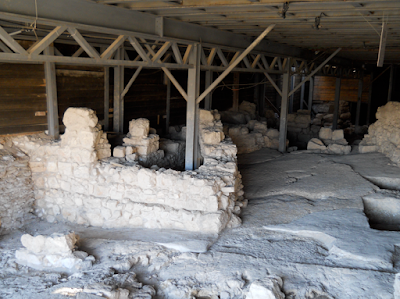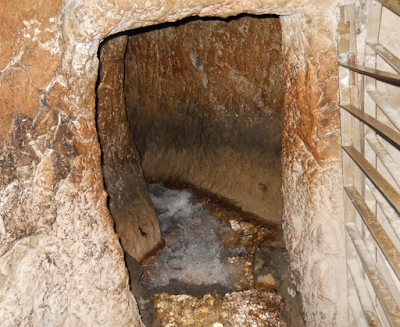Today, I had the opportunity to tour various Byzantine-era sites in the Old City of Jerusalem and the Mount of Olives with my Archaeology of Jerusalem class. In the Old City, we took a tour of the walled citadel, which includes the landmark Tower of David. Like most places in Jerusalem, this location was misinterpreted to be the site of the palace of King David; however, the name has stuck and successive structures built by Christian, Muslim, Mamluk, and Ottoman rulers have all been associated with David. Today, the citadel has been turned into a museum that explains the history of Jerusalem with several detailed models to help explain how the city has changed.
The imposing entrance to the citadel, today home to the Tower of David Museum.
The moat of the citadel.
A chandelier by famous glass sculptor Dale Chihuly hangs in the entrance of the Tower of David Museum.
The inside of the citadel features an incredible archeological park.
The view from the top of the citadel looks out at the entire Old City. The gold dome to the left is the Dome of the Rock; the white dome to the right is the Churva Synagogue.
A view of the Church of the Holy Sepulchre, the holiest site in Christianity. This was one of the focuses of our previous field trip.
A close-up of the Dome of the Rock. The gold domes of the Russian Orthodox Church of Mary Magdalene can be seen to the right.
A view of the Student Village--Kfar HaStudentim--where I live.
A view of the Mount Scopus campus of the Hebrew University of Jerusalem.
Idols were found in excavations of Jerusalem. These are what the biblical prophets warned against, fearing that people would shift their devotion away from G-d.
A reconstruction of Robinson's Arch, which carried traffic from the street-level market to the basilica, known as the Royal Stoa, on the Temple Mount. Today, there is only...
A model of Jerusalem during the Second Temple period. The walled city was much more expansive than today's walled city, which was built by the Ottoman Turks in the sixteenth century.
Glass grass sculptures by Dale Chihuly.
Kids were playing a large game of Chutes and Ladders in the center of the citadel.
When we finished at the Tower of David Museum, a bus took us to the Mount of Olives. The Mount of Olives is famous for two things: the largest, most ancient Jewish cemetery in the world and the location of many of the stories of Jesus from the New Testament.
The Chapel of the Ascension, where Jesus allegedly ascended into heaven 40 days after his resurrection.
A stone slab that supposedly contains one of Jesus' footprints.
The Chapel of the Ascension is one of Christianity's most venerated sites, but it has been turned into a Muslim mosque.
A view of the largest, most anceint Jewish cemetery in the world. The Temple Mount and the Dome of the Rock is in the background.
The Roman Catholic Dominus Flevit church marking the spot where Jesus wept over the coming destruction of Jerusalem.
A Byzantine-era mosaic in the Dominus Flevit church.
The old gnarled olive trees of the Garden of Gethsemane, where Jesus and his disciples prayed the night before his crucifixion. The word Gethsemane comes from the Hebrew words Gat Shemenim, which means oil press in English.
The mosaic facade of the Roman Catholic Church of All Nations, where Jesus prayed before his arrest. The mosaic depicts Jesus as a mediator between G-d and man.
The rock in the apse of the church where Jesus prayed before his arrest.
The Crusader facade of Mary's Tomb.








































































